With the rapid development Internet of Things (IoT) in recent years, there has been an explosion in time series data. Based on the growth trends of database types in DB-Engines over the past two years, the growth of time series database has been immense. Implementations of these large open source time series databases are different, and none of them are perfect. However, the advantages of these databases can be combined to implement a perfect time series database.
Alibaba Cloud Table Store is a distributed NoSQL database developed by Alibaba Cloud. Table Store uses a multi-model design, including the same Wide Column model as BigTable and Time series model for message data. In terms of storage model, data size, and write and query capabilities, it can meet the needs of time-series data scenarios. However, as a general-purpose model database, the time series data storage should fully utilize the capabilities of the underlying database. In the schema design and computational docking, there must be a special design, such as OpenTSDB's RowKey design for HBase and UID encoding.
This article focuses on data model definitions and core processing flows for time series data, and the architecture for building time series data storage based on Table Store. We will first talk about time series data and then discuss how we can process this data for our business applications with Table Store.

The time series data is mainly divided into two types, for monitoring and for status. Current open source time series databases are aimed at time series data for monitoring, and some specific optimizations are made for the data characteristics in this scenario. In terms of the characteristics of time series data, the other type is time series data for status. The two types of time series data correspond to different scenarios. The monitoring type corresponds to the monitoring scenario, and the status type is for other scenarios, such as tracing and abnormal status recording. The most common package trace is the time series data for status.
The reason why both types of data are classified into time series is that these types are completely consistent in data model definition, data collection, data storage and computing, and the same database and the same technical architecture can be abstracted.
Before defining the time series data model, we first make an abstract representation of the time series data.

The above is an abstract representation of the time series data. Each open source time series database has its own definition of the time series data model, defining the time series data for monitoring. The data model of OpenTSDB is used as an example:

The monitoring time series data model definition includes:
The monitoring time series data is the most typical type of time series data, and has specific characteristics. The characteristics of the monitoring time series data determine that such time series databases have specific storage and computing methods. Compared with the status time series data, it has specific optimizations in computing and storage. For example, the aggregation computing has several specific numerical aggregate functions, and there will be specially optimized compression algorithms on the storage. In the data model, the monitoring time series data usually does not need to express the location, while the overall model is in line with our unified abstract representation of the time series.
Based on the monitoring time series data model, we can define a complete model of the time series data according to a time series data abstract model described above:
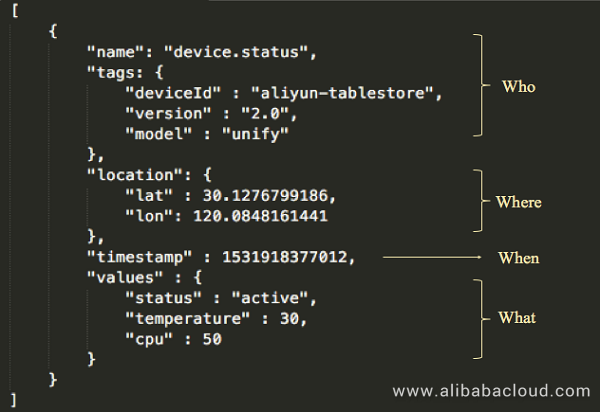
The definition includes:
This is a more complete time series data model, and has two main differences with the model definition of the monitoring time series data of OpenTSDB: first, there is one more dimension, location, in metadata; second, it can express more values.
Time series data has its own query and computing methods, which roughly include:
Time series retrieval
According to the data model definition, name + tags + location can be used to locate an individual, which has a time series, and the points on the time series are timestamps and values. For the query of time series data, first the time series needs to be located, which is a process of retrieval based on a combination of one or more values of the metadata. You can also drill down based on the association of metadata.
Time range query
After the Time series is located through retrieval, the time series is queried. There are very few queries on single time points on a time series, and queries are usually on all points in a continuous time range. Interpolation is usually done for missing points in this continuous time range.
Aggregation
A query can be for a single time series or multiple time series. For range queries for multiple time series, the results are usually aggregated. This aggregation is for values at the same time point on different time series, commonly referred to as "post-aggregation."
The opposite of "post-aggregation" is "pre-aggregation", which is the process of aggregating multiple time series into one time series before time series data storage. Pre-aggregation computes the data and then store it, while post-aggregation queries the stored data and then computes it.
Downsample
The computational logic of downsample is similar with that of aggregation. The difference is that down sampling is for a single time series instead of multiple time series, which aggregates the data points in a time range in a single time series. One of the purposes of downsample is to make the presentation of data points in a large time range, another is to reduce storage costs.
Analysis
Analysis is to extract more value from the time series data. There is a special research field called "time series analysis".
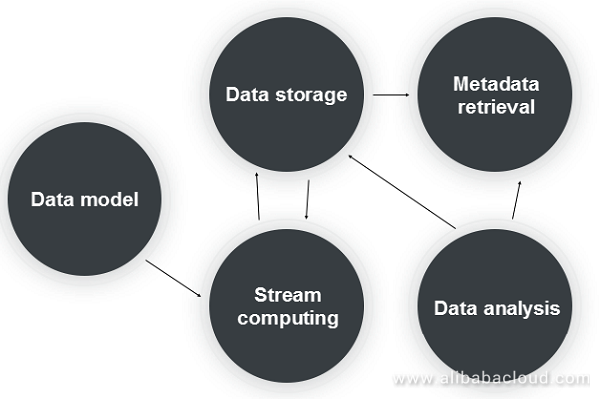
The core procedure of time series data processing is as shown above, including:
Let us see the products that can be used in product selection in these core processes.
Data storage
Time series data is typical non-relational data. It is characterized by high concurrency, high throughput, large data volume, and high write and low read. The query mode is usually range query. For these data characteristics, it is very suitable to use a database such as NoSQL. Several popular open source time series databases use NoSQL database as the data storage layer, such as OpenTSDB based on HBase, and KairosDB based on Cassandra. Therefore, for the product selection of "data storage", an open source distributed NoSQL database such as HBase or Cassandra, or a cloud service such as Alibaba Cloud's Table Store can be selected.
Stream computing
For stream computing, open source products such as JStrom, Spark Streaming, and Flink, or Alibaba's Blink and cloud product StreamCompute on the cloud can be used.
Metadata search
Metadata for the time series will also be large in magnitude, so a distributed database is first considered. In addition, because the query mode needs to support retrieval, the database needs to support interted index and spatial index, and open source Elasticsearch or Solr can be used.
Data analysis
Data analysis requires a powerful distributed computing engine, open source Spark, cloud product MaxCompute, or a serverless SQL engine such as Presto or cloud product Data Lake Analytic can be selected.

Based on the database development trends on DB-Engines, we see that time series databases have developed rapidly over the past two years, and a number of excellent open source time series databases have emerged. Each implementation of major time series databases also has its own merits. Here is a comprehensive comparison from some dimensions:
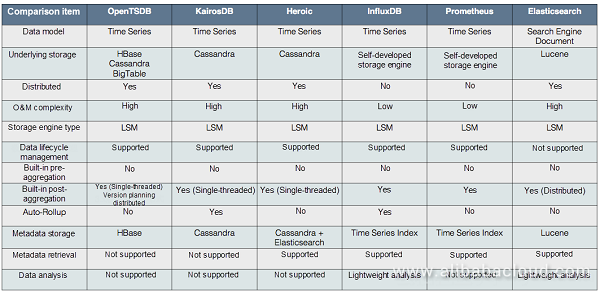
As a distributed NoSQL database developed by Alibaba Cloud, Table Store uses the same Wide Column model as Bigtable in terms of data model. The product is well-suited for time series data scenarios in terms of storage model, data size, and write and query capabilities. We have also supported monitoring time series products such as CloudMonitor, status time series products such as AliHealth's drug tracing, and core services such as postal package trace. There is also a complete computing ecosystem to support the computing and analysis of time series data. In future planning, we have specific optimizations for time series scenarios in terms of metadata retrieval, time series data storage, computing and analysis, and cost reduction.
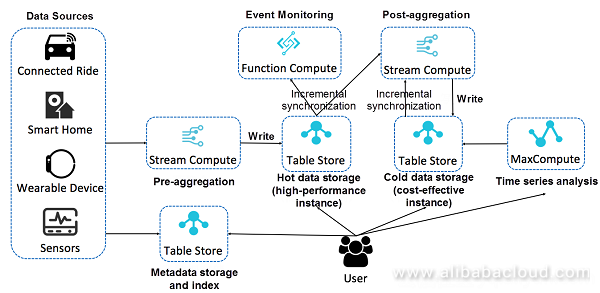
The above is a complete architecture of time series data storage, computing, and analysis based on Table Store. This is a serverless architecture that implement all the features needed to provide a complete time series scenario by combining cloud products. Each module has a distributed architecture, providing powerful storage and computing capabilities, and resources can be dynamically expanded. Each component can also be replaced with other similar cloud products. The architecture is flexible and has great advantages over open source time series databases. The core advantages of this architecture are analyzed below:
Separation of storage and computing
Separation of storage computing is a leading technical architecture. Its core advantage is to provide more flexible computing and storage resource configuration, with more flexible cost, and better load balancing and data management. In the cloud environment, to allow users to truly take advantage of the benefits brought by the separation of storage and computing, products for the separation of storage and computing need to be provided.
Table Store implements separation of storage and computing in both technical architecture and product form, and can freely allocate storage and computing resources at a relatively low cost. This is especially important in the time series data scenario, where computing is a relatively constant, and the storage grows linearly. The primary way to optimize costs is to allocate constant computing resources and infinitely scalable storage, without the extra computing cost.
Separation of cold/hot data
A notable feature of time series data is that there is distinctive hot and cold data access, and recently written data is accessed more frequently. Based on this feature, the hot data adopts storage medium with a higher IOPS, which greatly improves the overall query efficiency. Table Store provides two types of instances: high-performance instances and cost-effective instances, corresponding to SSD and SATA storage media respectively. The service feature allows users to freely allocate tables with different specifications according to data of different precisions and different performance requirements for query and analysis. For example, for high-concurrency and low-latency queries, high-performance instances are allocated; for cold data storage and low-frequency queries, cost-effective instances are allocated. For interactive data analysis that requires high speed, high-performance instances can be allocated. For scenarios of time series data analysis and offline computing, cost-effective instances can be allocated.
For each table, the lifecycle of the data can be freely defined, for example, for a high-precision table, a relatively short lifecycle can be configured. For a low-precision table, a longer lifecycle can be configured.
The bulk of the storage is for cold data. For this part of less-frequently accessed data, we will further reduce the storage cost through Erasing Coding and the ultimate compression algorithm.
Closed loop of data flow
Stream computing is the core computing scenario in time series data computing, which performs pre-aggregation and post-aggregation on the time series data. The common monitoring system architecture uses a front stream computing solution. Pre-aggregation and downsample of the data are all performed in the front stream computing. That is, the data has been processed before it is stored, and what is stored is only the result. A second downsample is no longer required, and only the query of post-aggregation may be required.
Table Store is deeply integrated with Blink and is now available as a Blink maintenance table and a result table. The source table has been developed and is ready for release. Table Store can be used as the source and back-end of Blink, and the entire data stream can form a closed loop, which can bring more flexible computing configuration. The original data will subject to a data cleansing and pre-aggregation after entering the Blink, and then is written to the hot data table. This data can automatically flow into Blink for post-aggregation, and historical data backtracking for a certain period of time is supported. The results of post-aggregation can be written to the cold storage.
In addition to integrating with Blink, Table Store can also integrate with Function Compute for event programming, and can enable real-time abnormal status monitoring in time series scenarios. It can also read incremental data through the Stream APIs for custom analysis.
Big data analysis engine
Table Store deeply integrates with distributed computing engines developed by Alibaba Cloud, such as MaxCompute (formerly ODPS). MaxCompute can directly read the data on the Table Store for analysis, eliminating the ETL process for data.
There are some optimizations in the entire analysis process, for example, optimization of queries through the index, and providing more operators for computing pushdown at the bottom.
Service capabilities
In a word, Table Store's service capabilities are characterized by zero-cost integration, out-of-the-box, global deployment, multi-language SDK, and fully managed services.
Metadata storage and retrieval
Metadata is also a very important part in time series data. It is much smaller than the time series data in terms of volume, but it is much more complicated than the time series data in query complexity.
From the definition we provided above, metadata is mainly divided into Tags and Location. Tags are mainly used for multidimensional retrieval, and Location is mainly for location retrieval. So for the underlying storage, Tags must implement the inverted rank index for providing efficient retrieval, and the Location needs to implement the location index. The order of time series for a service-level monitoring system or tracing system is 10 million to 100 million, or higher. Metadata also needs a distributed retrieval system to provide a high-concurrency low-latency solution, and a preferable implementation in the industry is to use Elasticsearch for the storage and retrieval of metadata.
Alibaba Cloud Table Store is a general-purpose distributed NoSQL database that supports multiple data models. The data models currently available include Wide Column (BigTable) and time series (message data model).
In applications of similar database products (such as HBase and Cassandra) in the industry, time series data is a very important field. Table Store is constantly exploring in the time series data storage. We are constantly improving in the process of closed loop of stream computing data, data analysis optimization, and metadata retrieval, to provide a unified time series data storage platform.
Perform Serverless Query and Export Visualized BI Reports on Alibaba Cloud

57 posts | 12 followers
FollowAlibaba Cloud Storage - May 8, 2019
Alibaba Cloud Storage - November 8, 2018
Apache Flink Community China - September 15, 2022
Alibaba Cloud Storage - March 28, 2019
zhuoran - February 5, 2021
Alibaba Cloud Storage - April 25, 2019

Conceivably, I think it will be good if you take few samples of row key design and how it will affect the hotspot problems. The performance issues that take effect on CPU,memories with queries and insert.The row key design from HBase with keys going to each region in region server and how the distribution happens, even and uneven and then OpenTSDB and from there it will be easy to draw to Table Store.

57 posts | 12 followers
Follow IoT Platform
IoT Platform
Provides secure and reliable communication between devices and the IoT Platform which allows you to manage a large number of devices on a single IoT Platform.
Learn More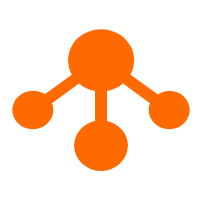 Tablestore
Tablestore
A fully managed NoSQL cloud database service that enables storage of massive amount of structured and semi-structured data
Learn More IoT Solution
IoT Solution
A cloud solution for smart technology providers to quickly build stable, cost-efficient, and reliable ubiquitous platforms
Learn More ApsaraDB for HBase
ApsaraDB for HBase
ApsaraDB for HBase is a NoSQL database engine that is highly optimized and 100% compatible with the community edition of HBase.
Learn MoreMore Posts by Alibaba Cloud Storage
Raja_KT January 26, 2019 at 7:14 am
How about HiTSDB on beta ?https://www.alibabacloud.com/help/doc-detail/55652.htm?spm=a2c63.l28256.a3.1.62e8478aD3AUVdI put in forum